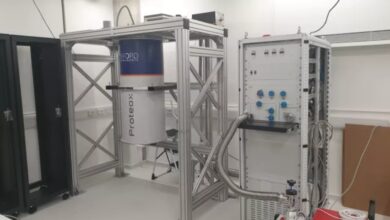Revolutionary Discovery: New Magnetism Could Boost Electronics Speed by 1000 Times

Nottingham, UK –What could be a pivotal moment for the future of electronics, researchers at the University of Nottingham have discovered and imaged a new type of magnetism termed “altermagnetism.” This groundbreaking finding is poised to revolutionize the field of magnetic memory technology, promising to make electronic devices up to a thousand times faster than current standards.
Altermagnetism, as detailed in a recent study published in the journal Nature, blends the characteristics of both ferromagnetism and antiferromagnetism, two well-known forms of magnetic order. Ferromagnets, like those found on refrigerator doors, have all magnetic moments aligned in one direction, creating a strong external magnetic field. Antiferromagnets, on the other hand, have magnetic moments that alternate, canceling out any net magnetism externally but possessing intricate internal magnetic properties.
The newly discovered altermagnetism introduces a third category where the magnetic building blocks are antiparallel yet rotated in structure compared to their neighbors. This unique alignment allows for no net macroscopic magnetization but does feature a significant spin polarization in the electronic band structure, potentially enabling ultrafast data processing.
Impact on Technology:
The implications of this discovery are profound. Traditional electronics rely on the charge of electrons, but with altermagnetism, the spin state of electrons can be leveraged in spintronics—a burgeoning field where data is stored and processed using the spin of electrons rather than just their charge. This could lead to:
Faster Data Access: By using altermagnets, data could be written and read at speeds dramatically higher than with current technologies.
Energy Efficiency: The unique properties of altermagnets could reduce energy consumption in electronic devices, making them more environmentally friendly.
Compact Storage: Without the external magnetic fields of ferromagnets, altermagnets could allow for denser packing of memory units, potentially increasing storage capacity in devices.
The research was conducted using advanced techniques at the MAX IV synchrotron facility in Sweden, where scientists could visualize and manipulate altermagnetic ordering at the nanoscale. This was achieved by employing X-ray magnetic circular dichroism and magnetic linear dichroism, alongside photoemission electron microscopy, demonstrating the material’s potential in real-world applications.
Future Prospects:
According to Peter Wadley from the University of Nottingham, “This discovery opens the door to new types of memory devices and could fundamentally change how we think about magnetic materials in technology.” PhD student Alfred Dal Din, who has been part of the research team, expressed excitement about being at the forefront of this new class of materials, noting, “Seeing the properties of this promising new class of magnetic materials firsthand has been both challenging and immensely rewarding.”
The study’s findings suggest that in the next 5 to 10 years, altermagnets could start making their way into commercial applications, potentially transforming the landscape of digital and neuromorphic computing. This could also reduce the dependency on rare and often toxic elements used in current magnetic technologies, further lowering the environmental impact.
As the digital world looks for the next leap in computing power and efficiency, altermagnetism stands out as a beacon of innovation, potentially heralding a new era in electronics that is faster, smarter, and more sustainable.




